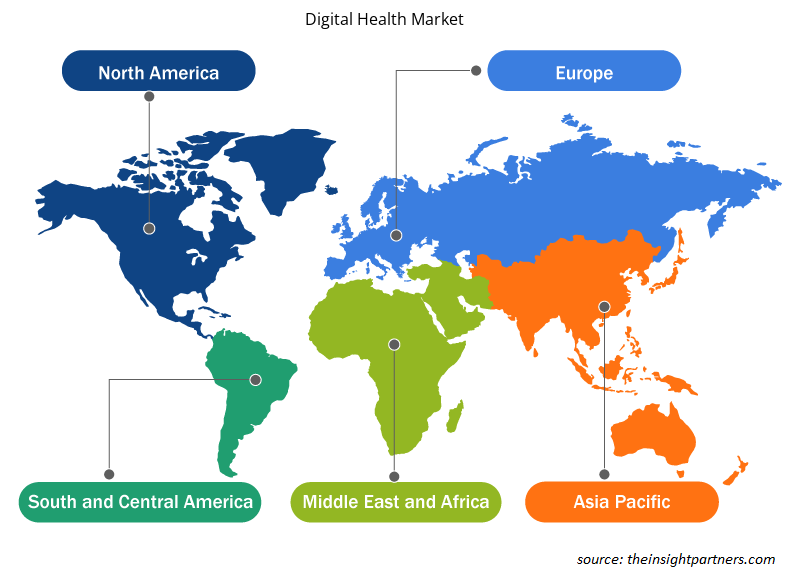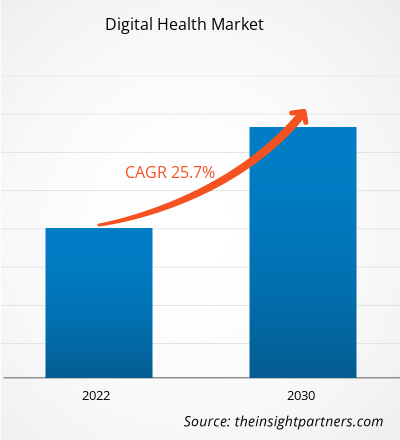[研究报告] 数字健康市场预计将从 2022 年的 3064.4304 亿美元增长到 2030 年的 19095.2456 亿美元;预计 2022 年至 2030 年市场复合年增长率为 25.7%。CAGR of 25.7% from 2022 to 2030.
分析师观点:
数字医疗市场预测可以帮助该市场的利益相关者制定增长战略。数字医疗市场的增长因素包括互联网连接和智能设备普及率的提高、政府监管支持和政策举措的增加以及医疗 IT 基础设施的技术发展,这些因素推动了数字医疗市场的增长。然而,与数据和隐私泄露相关的安全问题阻碍了市场的增长。
数字健康需要利用医疗行业的信息和通信技术来远程管理慢性疾病。数字健康市场包括移动医疗 (mHealth)、可穿戴设备、远程医疗和远程医疗、健康信息技术 (IT) 和定制医疗。它为消费者提供各种服务,包括早期识别危及生命的疾病和慢性病管理。数字健康带来的好处将对数字健康市场规模产生积极影响
市场洞察:
政府监管支持和政策举措不断增加,推动数字健康市场增长
监管支持和政府举措对于塑造和推进数字健康至关重要。这些努力包括各种政策、法规、融资机制和战略举措,以提高数字健康解决方案的采用、整合和有效性。例如,美国国际开发署 (USAID) 设想利用数字技术使个人能够获取关键信息和服务,从而实现健康和富足的生活。该机构制定了专门的政策指南“数字健康行动愿景”,指导其对支持伙伴国家健康计划的数字技术的投资。同样,2022 年,印度政府启动了 Ayushman Bharat 数字健康使命 (ABDM),以创建数字健康生态系统。同样,2021 年 10 月,法国政府投资超过 6.5 亿美元来增强其国家数字健康基础设施。
此外,世界卫生组织(WHO)在其《国家电子健康战略》或《数字健康工具包》中将数字健康定义为“信息和通信技术(ICT)在健康领域的应用”。据世卫组织称,2020年,超过75%的合格提供者和90%的合格医院因参与政府鼓励医院允许患者查看、下载和传输其健康信息的计划而获得资金。2020年5月,美国联邦政府提出了《2020-2025年联邦卫生IT战略计划》,要求医疗保健提供者使用EHR。ICT) to Health" in its National Strategy for EHR by healthcare providers.
因此,上述因素将促进数字健康市场份额的扩大
定制此报告以满足您的需求
您可以免费定制任何报告,包括本报告的部分内容、国家级分析、Excel 数据包,以及为初创企业和大学提供优惠和折扣
- 获取此报告的关键市场趋势。这个免费样品将包括数据分析,从市场趋势到估计和预测。
报告细分和范围:
“数字健康市场分析”是通过考虑以下部分来进行的:产品、技术、应用和最终用户。
这全球数字医疗市场根据产品细分,技术,应用,最终用户和地理位置。根据产品类型,数字健康市场分为软件、服务和硬件。数字医疗市场按技术细分为移动医疗、远程医疗、数字医疗系统等。按应用细分为慢性病管理、行为健康、健康和健身等。按最终用户划分,数字健康市场分为医院和诊所、患者和消费者等。医院和诊所占据了最大的数字健康市场份额。
从地理上看,全球数字健康市场报告分为北美(美国、加拿大和墨西哥)、欧洲(德国、法国、意大利、英国、西班牙和欧洲其他地区)、亚太地区(中国、日本、印度、澳大利亚、韩国和亚太其他地区)、中东和非洲(南非、沙特阿拉伯、阿联酋和中东和非洲其他地区)以及南美洲和中美洲(巴西、阿根廷和南美洲和中美洲其他地区)。
基于产品的洞察
根据产品类型,数字医疗市场可细分为软件、服务和硬件。服务部门在 2022 年占据了最大的市场份额,预计在 2022-2030 年期间将实现最高的复合年增长率。
基于技术的见解
按技术划分,数字医疗市场分为移动医疗、远程医疗、数字医疗系统等。移动医疗领域在 2022 年占据了最大的市场份额。预计远程医疗领域在 2022 年至 2030 年期间增长最快。
基于应用的洞察
根据应用,数字健康市场分为慢性病管理、行为健康、健康和健身等。2022 年,慢性病管理领域占据了最大的市场份额。
基于最终用户的洞察
根据最终用户,数字健康市场分为医院和诊所、患者和消费者以及其他。2022 年,医院和诊所部门占据了最大的市场份额。
区域分析:
根据地理位置,全球数字健康市场分为亚太地区、欧洲、中东和非洲、北美以及南美和中美。2022 年,北美占据全球市场的最大份额。预计 2022 年至 2030 年期间亚太地区的复合年增长率最高。
北美的数字医疗市场分为美国、加拿大和墨西哥。 数字医疗的转型和智能医疗解决方案的日益普及,包括各种技术,如移动应用程序、智能可穿戴设备以及电子健康服务,如 EHR 和远程医疗服务,这些服务允许远程患者监控,是推动市场发展的主要因素。其他因素,如医疗保健领域先进软件技术的引入、医院数量的增加以及政府战略政策的实施,也有助于促进数字医疗市场的发展。
美国是北美乃至全球数字健康市场的最大贡献者。2020 年 9 月,美国食品药品管理局 (FDA) 成立了数字健康卓越中心。该中心的成立是该机构致力于促进数字健康技术进步的重要一步。这包括移动健康设备、 医疗设备软件(SaMD)、用作医疗设备的可穿戴设备以及用于研究医疗产品的技术。此外,该国领先的市场参与者的存在及其发展可能会有利于市场的增长。
数字健康市场区域洞察
Insight Partners 的分析师已详细解释了预测期内影响数字健康市场的区域趋势和因素。本节还讨论了北美、欧洲、亚太地区、中东和非洲以及南美和中美洲的数字健康市场细分和地理位置。

- 获取数字健康市场的区域特定数据
数字健康市场报告范围
| 报告属性 | 细节 |
|---|---|
| 2022 年市场规模 | 3064.4304 亿美元 |
| 2030 年的市场规模 | 19095.2456 万美元 |
| 全球复合年增长率(2022 - 2030 年) | 25.7% |
| 史料 | 2020-2022 |
| 预测期 | 2022-2030 |
| 涵盖的领域 | 通过奉献
|
| 覆盖地区和国家 | 北美
|
| 市场领导者和主要公司简介 |
|
数字健康市场参与者密度:了解其对业务动态的影响
数字健康市场正在快速增长,这得益于终端用户需求的不断增长,而这些需求又源于消费者偏好的不断变化、技术进步以及对产品优势的认识不断提高等因素。随着需求的增加,企业正在扩大其产品范围,进行创新以满足消费者的需求,并利用新兴趋势,从而进一步推动市场增长。
市场参与者密度是指在特定市场或行业内运营的企业或公司的分布情况。它表明在给定市场空间中,相对于其规模或总市场价值,有多少竞争对手(市场参与者)存在。
在数字健康市场运营的主要公司有:
- Cerner 公司
- 临床研究
- Allscripts医疗保健解决方案公司
- 霍尼韦尔国际公司
- 思科系统
免责声明:上面列出的公司没有按照任何特定顺序排列。

- 了解数字健康市场顶级关键参与者概况
行业发展和未来机遇:
- 2022 年 10 月,Medulance 与 Reliance Jio 合作推出了一款 5G 救护车。该车配备智能设备和摄像头,具有双向音频和视频通信、高清镜头传输、位置跟踪以及通过高速互联网网络向远程医生实时传输患者健康数据的功能。
- 2021 年 6 月,亚马逊推出了数字健康加速器 AWS Healthcare Accelerator,以支持医疗保健虚拟护理和分析领域的初创企业。该计划优先考虑远程患者监控、数据分析、患者参与、语音技术和虚拟护理。
- 2021 年 10 月,德勤和沃达丰宣布建立战略联盟,通过沃达丰与德勤的医疗健康中心,让整个欧洲的人们能够更方便地获得医疗服务。此次合作旨在加快互联医疗的普及。该虚拟中心将沃达丰的互联医疗解决方案与德勤的医疗咨询专业知识相结合,让个人无论何时何地都需要医疗服务,都能更方便地获得医疗服务。
Cerner Corporation、Eclinicalworks、Allscripts Healthcare Solutions Inc.、Honeywell International Inc.、思科系统、GE Healthcare、Koninklijke Philips NV、西门子医疗股份公司、高通技术公司和 Fitbit 公司是数字健康市场报告中介绍的知名公司。这些领先企业专注于扩大和多样化其市场影响力和客户群,挖掘数字健康市场中的商机。
- 历史分析(2 年)、基准年、预测(7 年)及复合年增长率
- PEST 和 SWOT 分析
- 市场规模价值/数量 - 全球、区域、国家
- 行业和竞争格局
- Excel 数据集


- Wind Turbine Composites Market
- Genetic Testing Services Market
- Adaptive Traffic Control System Market
- Dropshipping Market
- Artificial Intelligence in Healthcare Diagnosis Market
- Cut Flowers Market
- Diaper Packaging Machine Market
- Embolization Devices Market
- Oxy-fuel Combustion Technology Market
- Workwear Market

Report Coverage
Revenue forecast, Company Analysis, Industry landscape, Growth factors, and Trends

Segment Covered
This text is related
to segments covered.

Regional Scope
North America, Europe, Asia Pacific, Middle East & Africa, South & Central America

Country Scope
This text is related
to country scope.
常见问题
Digital health refers to the implementation of digital technologies in the healthcare industry, including software, hardware, and related services. Several technologies fall under the umbrella of digital health, such as mobile health (mHealth) apps, wearable devices, electronic health records (EHRs), electronic medical records (EMRs), telemedicine, telehealth, and personalized medicine, among others.
The digital health market majorly consists of the players, including Cerner Corporation, Eclinicalworks, Allscripts Healthcare Solutions Inc., Honeywell International Inc., Cisco Systems, General Electric Company, Koninklijke Philips N.V., Siemens Healthineers AG, Qualcomm Technologies, Inc., Fitbit, Inc.
Key factors driving the growth of the digital health market are increasing internet connectivity and smart device penetration, rising government regulatory support and policy initiatives, and technological development in healthcare IT infrastructure.
The digital health market, by end-user, is segmented into hospitals & clinics, patients & consumers, and others. In 2022, the hospitals & clinics segment held the largest market share.
The digital health market was valued at US$ 306,443.04 billion in 2022.
The digital health market, by technology, is segmented into antibacterial drugs, antiviral drugs, antifungal drugs, and others. The mHealth segment held a larger market share in 2022. However, telehealthcare segment is anticipated to register a higher CAGR during 2022-2030.
Trends and growth analysis reports related to Technology, Media and Telecommunications : READ MORE..
The List of Companies - Digital Health Market
- Cerner Corporation
- Eclinicalworks
- Allscripts Healthcare Solutions Inc.
- Honeywell International Inc.
- Cisco Systems
- GE Healthcare
- Koninklijke Philips N.V.
- Siemens Healthineers AG
- Qualcomm Technologies, Inc.
- Fitbit, Inc.
The Insight Partners performs research in 4 major stages: Data Collection & Secondary Research, Primary Research, Data Analysis and Data Triangulation & Final Review.
- Data Collection and Secondary Research:
As a market research and consulting firm operating from a decade, we have published and advised several client across the globe. First step for any study will start with an assessment of currently available data and insights from existing reports. Further, historical and current market information is collected from Investor Presentations, Annual Reports, SEC Filings, etc., and other information related to company’s performance and market positioning are gathered from Paid Databases (Factiva, Hoovers, and Reuters) and various other publications available in public domain.
Several associations trade associates, technical forums, institutes, societies and organization are accessed to gain technical as well as market related insights through their publications such as research papers, blogs and press releases related to the studies are referred to get cues about the market. Further, white papers, journals, magazines, and other news articles published in last 3 years are scrutinized and analyzed to understand the current market trends.
- Primary Research:
The primarily interview analysis comprise of data obtained from industry participants interview and answers to survey questions gathered by in-house primary team.
For primary research, interviews are conducted with industry experts/CEOs/Marketing Managers/VPs/Subject Matter Experts from both demand and supply side to get a 360-degree view of the market. The primary team conducts several interviews based on the complexity of the markets to understand the various market trends and dynamics which makes research more credible and precise.
A typical research interview fulfils the following functions:
- Provides first-hand information on the market size, market trends, growth trends, competitive landscape, and outlook
- Validates and strengthens in-house secondary research findings
- Develops the analysis team’s expertise and market understanding
Primary research involves email interactions and telephone interviews for each market, category, segment, and sub-segment across geographies. The participants who typically take part in such a process include, but are not limited to:
- Industry participants: VPs, business development managers, market intelligence managers and national sales managers
- Outside experts: Valuation experts, research analysts and key opinion leaders specializing in the electronics and semiconductor industry.
Below is the breakup of our primary respondents by company, designation, and region:

Once we receive the confirmation from primary research sources or primary respondents, we finalize the base year market estimation and forecast the data as per the macroeconomic and microeconomic factors assessed during data collection.
- Data Analysis:
Once data is validated through both secondary as well as primary respondents, we finalize the market estimations by hypothesis formulation and factor analysis at regional and country level.
- Macro-Economic Factor Analysis:
We analyse macroeconomic indicators such the gross domestic product (GDP), increase in the demand for goods and services across industries, technological advancement, regional economic growth, governmental policies, the influence of COVID-19, PEST analysis, and other aspects. This analysis aids in setting benchmarks for various nations/regions and approximating market splits. Additionally, the general trend of the aforementioned components aid in determining the market's development possibilities.
- Country Level Data:
Various factors that are especially aligned to the country are taken into account to determine the market size for a certain area and country, including the presence of vendors, such as headquarters and offices, the country's GDP, demand patterns, and industry growth. To comprehend the market dynamics for the nation, a number of growth variables, inhibitors, application areas, and current market trends are researched. The aforementioned elements aid in determining the country's overall market's growth potential.
- Company Profile:
The “Table of Contents” is formulated by listing and analyzing more than 25 - 30 companies operating in the market ecosystem across geographies. However, we profile only 10 companies as a standard practice in our syndicate reports. These 10 companies comprise leading, emerging, and regional players. Nonetheless, our analysis is not restricted to the 10 listed companies, we also analyze other companies present in the market to develop a holistic view and understand the prevailing trends. The “Company Profiles” section in the report covers key facts, business description, products & services, financial information, SWOT analysis, and key developments. The financial information presented is extracted from the annual reports and official documents of the publicly listed companies. Upon collecting the information for the sections of respective companies, we verify them via various primary sources and then compile the data in respective company profiles. The company level information helps us in deriving the base number as well as in forecasting the market size.
- Developing Base Number:
Aggregation of sales statistics (2020-2022) and macro-economic factor, and other secondary and primary research insights are utilized to arrive at base number and related market shares for 2022. The data gaps are identified in this step and relevant market data is analyzed, collected from paid primary interviews or databases. On finalizing the base year market size, forecasts are developed on the basis of macro-economic, industry and market growth factors and company level analysis.
- Data Triangulation and Final Review:
The market findings and base year market size calculations are validated from supply as well as demand side. Demand side validations are based on macro-economic factor analysis and benchmarks for respective regions and countries. In case of supply side validations, revenues of major companies are estimated (in case not available) based on industry benchmark, approximate number of employees, product portfolio, and primary interviews revenues are gathered. Further revenue from target product/service segment is assessed to avoid overshooting of market statistics. In case of heavy deviations between supply and demand side values, all thes steps are repeated to achieve synchronization.
We follow an iterative model, wherein we share our research findings with Subject Matter Experts (SME’s) and Key Opinion Leaders (KOLs) until consensus view of the market is not formulated – this model negates any drastic deviation in the opinions of experts. Only validated and universally acceptable research findings are quoted in our reports.
We have important check points that we use to validate our research findings – which we call – data triangulation, where we validate the information, we generate from secondary sources with primary interviews and then we re-validate with our internal data bases and Subject matter experts. This comprehensive model enables us to deliver high quality, reliable data in shortest possible time.


 获取此报告的免费样本
获取此报告的免费样本